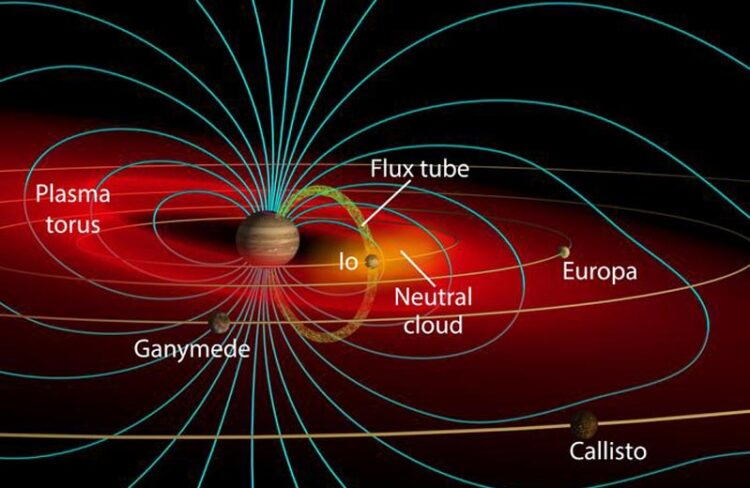SwRI will lead Hubble, Webb observations of Io, Jupiter’s volcanic moon

Southwest Research Institute will lead a large Space Telescope Science Institute project using the Hubble and James Webb telescopes to remotely study Io during complementary flybys of the Jupiter moon by NASA’s Juno spacecraft. Juno’s upcoming flybys offer an excellent opportunity for combining intensive in situ measurements with Earth-based remote sensing to understand Io’s volcanic contributions to the plasma environment around Jupiter.
Credit: SwRI/John Spencer
Remote-sensing data will complement Juno spacecraft’s in situ observations.
The Space Telescope Science Institute recently awarded Southwest Research Institute a large project to use the Hubble and James Webb telescopes to remotely study Io, the most volcanically active body in the solar system. The study will complement the upcoming flybys of the Jupiter moon by NASA’s Juno spacecraft and will provide insights into Io’s contributions to the plasma environment around Jupiter. Large Hubble projects request 75 orbits or more; this project will collect data during 122 orbits, which is how Hubble telescope time is allocated.
“The timing of this project is critical. Over the next year, Juno will buzz past Io several times, offering rare opportunities to combine in situ and remote observations of this complex system,” said SwRI’s Dr. Kurt Retherford, principal investigator of the campaign, largely using 4.7% of available time for Hubble observations this cycle and supplemented with 4.8 hours of Webb observing time. “We hope to gain new insights into Io’s dramatic volcanism, plasma-moon interactions and the neutral gas and plasma populations that propagate through Jupiter’s vast magnetosphere and trigger intense Jovian auroral emissions.”
Io’s escaping atmosphere is the dominant source of material in the Jovian magnetosphere, a vast bubble of charged particles swirling around the gas giant. However, the connection between the volcanos, surface volatiles, atmosphere and magnetospheric plasma interaction to Io’s extended neutral clouds, the Io Plasma Torus (IPT) and Jupiter’s ionosphere remains difficult to quantify and understand.
“The couplings between time-variable processes are central to understanding the Jupiter system holistically,” said Dr. Fran Bagenal, the project’s co-principal investigator from the University of Colorado at Boulder. “For example, how much sulfur is transported from Io to Europa’s surface? How do auroral features on Io compare with aurora on Earth — the northern lights — and Jupiter?”
Io, the innermost large moon of Jupiter, supplies most of the charged particles in the planet’s magnetosphere. The IPT is a donut-shaped cloud of ions and electrons surrounding Jupiter, created when atmospheric gases escaping from Io are ionized. Electrons collide with the ions, which absorb energy from the collisions and release it as ultraviolet light, which can be detected by telescopes.
“Most of these materials don’t actually escape straight out of the volcanoes but rather are associated with the sublimation of sulfur dioxide frost from Io’s dayside surface,” said Caltech’s Dr. Katherine de Kleer, another coinvestigator with expertise in James Webb data analysis. “The interaction between Io’s atmosphere and the surrounding plasma provides the escape mechanism for gases released from the moon’s frozen surface.”
Juno’s primary mission studied Jupiter’s interior, magnetosphere and aurora, while its extended mission includes flybys of the Galilean moons. Juno’s Io flybys on Dec. 30, 2023, and Feb. 1, 2024, are especially close. A few other more distant passes will take place, with the Sept. 20, 2024, event observable by Hubble and Webb. While the Europa Clipper and Jupiter Icy Moons Explorer (JUICE) missions are scheduled to arrive at Jupiter in 2029-2031, neither of these missions fly by Io. Another opportunity to do this sort of research would not have been possible until the 2030s.
“The chance for a holistic approach to Io investigations has not been available since a series of Galileo spacecraft flybys in 1999-2000 were supported by Hubble with a prolific 30-orbit campaign,” Retherford said. “The combination of Juno’s intensive in situ measurements with our remote-sensing observations will undoubtedly advance our understanding of Io’s role in driving coupled phenomena in the Jupiter system.”
For more information, visit https://www.swri.org/planetary-science.
Media Contact
Deb Schmid
Southwest Research Institute
dschmid@swri.org
Office: 210-522-2254
All latest news from the category: Physics and Astronomy
This area deals with the fundamental laws and building blocks of nature and how they interact, the properties and the behavior of matter, and research into space and time and their structures.
innovations-report provides in-depth reports and articles on subjects such as astrophysics, laser technologies, nuclear, quantum, particle and solid-state physics, nanotechnologies, planetary research and findings (Mars, Venus) and developments related to the Hubble Telescope.
Newest articles

25 years after Lothar: How the windstorm rebuilt the forest
On the morning of December 26, 1999, the winter storm “Lothar” swept across Switzerland, knocking down around 14 million cubic meters of wood, three times the annual logging volume. WSL…

A new class of cosmic X-ray sources discovered
An international team of astronomers, led by researchers from the Astronomical Observatory of the University of Warsaw, have identified a new class of cosmic X-ray sources. The findings have been…

An open solution to improving research reproducibility
Academic and industry scientists collaborate on a new method to characterize research antibodies. Structural Genomics Consortium researchers at The Neuro (Montreal Neurological Institute-Hospital) of McGill University, in collaboration with scientists…



